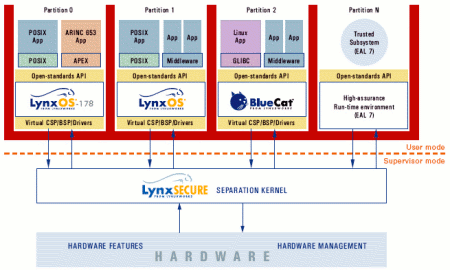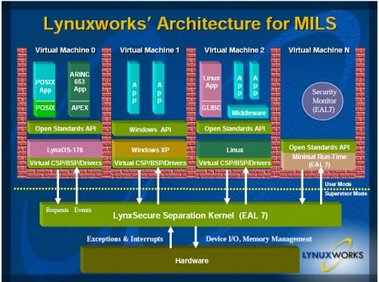Linux, open standards prominent at annual LynuxWorks media event
Feb 10, 2006 — by LinuxDevices Staff — from the LinuxDevices Archive — views[Updated Feb. 14] — Embedded RTOS and Linux vendor LynuxWorks highlighted the importance of open standards and open source software, off-the-shelf OSes, and reusable software, at a recent invitation-only media event. It announced two security-oriented OS products, and tipped plans to diversify its customer base by leveraging military/aerospace products in the commercial sector.
Dr. Inder Singh, CEO, opened LynuxWorks's Vision Summit event with a discussion on pervasive networks, which he said have become commonplace, resulting in an unprecedented proliferation of embedded systems in all walks of life. Device proliferation has also brought an increase in device complexity, he said, and a greatly increased need for reliability, safety, and security, in commercial as well as military/aerospace applications.
“In a world where everything is networked, embedded systems have become a part of the very fabric of our lives — whether we are aware of it or not. The network has now also extended to the battlefield, and embedded systems are commonplace in aircraft, sea-going vessels, military equipment and the devices carried by our soldiers,” Singh said.
In a statement issued subsequent to its Vision Summit event, LynuxWorks called Linux an “unstoppable force” and “the leading de facto open standard embedded platform” in both military and commercial systems. It noted that its long-time strategy of integrating open standards such as POSIX and Linux with its safety-certifiable RTOS (real-time operating system) products has helped it thrive and grow, at a time when it says some Linux-only vendors are struggling to survive.
A big part of LynuxWorks's recent growth and success derives from a major defense contract involving the Integrated Computer System (ICS) being developed across all military branches by the US Defense Department. LynuxWorks won the ICS contract, it said at the time, in large part because of the Linux Application Binary Interface layer available in its LynxOS-178 secure real-time product. Increasingly, US defense projects such as SOSCOE are being written on top of Linux, LynuxWorks said at the time.
A month after winning the ICS contract, LynuxWorks revealed details of its separation kernel, a low-level system kernel and scheduler aimed at running multiple embedded OSes — including Linux — within managed, secure partitions on top of a single hardware platform.

LynuxWorks's separation kernel architecture
(Click to enlarge)
Several other vendors, including Green Hills Software and Sysgo, have marketed at least superficially similar virtualization technology to military/aerospace customers. However, platform virtualization technologies are also beginning to proliferate in the commercial sector. Customers for Jaluna's OSWare product, for example, include NEPs (network equipment providers), mobile phone vendors, and set-top box makers.
LynuxWorks says that reliability and security assurance have growing importance to all embedded developers, and that technologies and products developed for aviation, military, and aerospace customers will “inevitably make their way into commercial products, especially in industries such as finance and telecommunications.” The company reports that it has grown quickly in recent years thanks to military contracts, but appears eager to diversify its customer base in the commercial sector.
One recent commercial-sector design win was a wireless Ethernet adapter from B&B Electronics.
Two new mil/aero RTOSes
Still, for now, LynuxWorks appears most closely focused on military/aerospace opportunities. The company announced two new OS products at its Vision Summit event — both focused on high-security military/aerospace applications.
The first, LynxSecure, aims to be the first operating system ever to achieve certifiability under EAL-7 (Evaluation Assurance Level 7), the highest level of security defined by the Common Critera. LynuxWorks says its separation kernel technology, along with its EAL-4-certifiable LynxOS-178 product, give it a “significant head start” toward creating an EAL-7-certifiable LynxSecure product.

LynxSecure architecture diagram
(Click to enlarge)
The second new product, LynxOS-SE, is described as a time-space partitioned, hard real-time, deterministic RTOS for medium assurance applications. LynxOS-SE will also be based on LynxOS-178.
Unlike LynxSecure, LynxOS-SE does not run multiple OSes within protected partitions. Instead, it offers partitions for various operating environments based on API- and ABI-compatibility layers. Supported application types include Linux, POSIX, JVM, and ARINC applications, LynuxWorks says. LynxOS-SE's Linux ABI compatibility allows many Linux binaries to run without modification, the company claims.
Reusable components
Another major theme at Vision Summit was the growing importance of providing embedded developers with reusable software components (RSC). Software has replaced hardware as the most time-consuming component of embedded development, according to Joe Wlad, director of product marketing. This has created demand among mil/aero customers for off-the-shelf OS products capable of meeting strict requirements set forth by the FAA (Federal Avionics Administration) and other regulatory bodies, while still offering enough versatility to support a range of uses.
Linux on the battlefield
Additionally, Osa Fitch, program executive of iRobot's government and industrial robotics division, presentated information, including video footage, of the R-Gator robotic unmanned ground vehicle (UGV) (pictured below). The R-Gator's control, navigation, and obstacle avoidance systems are based on LynuxWorks's BlueCat Linux, which features a 2.6 Linux kernel.

R-Gator in automous robotic follow mode
Stephen Balacco, an embedded systems market analyst with Venture Development Corporation (VDC), said, “LynuxWorks's success in 2005 and optimism for the future has allowed them to invest in their marketing programs, organizational structure, and product R&D. All these together should position LynuxWorks to capitalize on their momentum going into 2006. What remains then is the hard part: executing against the strategy and realizing the returns on those investments.”
This article was originally published on LinuxDevices.com and has been donated to the open source community by QuinStreet Inc. Please visit LinuxToday.com for up-to-date news and articles about Linux and open source.